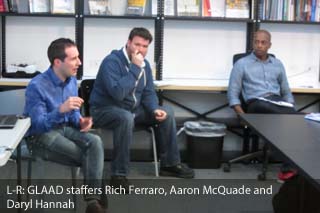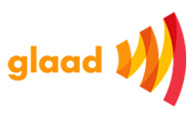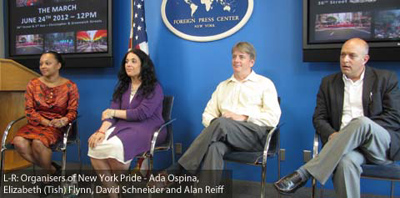
That’s where GLAAD comes in, said Rich Ferraro (right), Vice-president of communications for GLAAD – the Gay and Lesbian Alliance Against Defamation. The second headline sensationalises the person’s gender expression. GLAAD would go to the newspaper and ask: Is the person’s SOGI (sexual orientation and/or gender identity) relevant to the story, or was it being used to sensationalise it?
One might say the dress was a fact. But I would put the issue thus: If another robber wore a large crucifix, would we see a headline saying “Man with crucifix robs drugstore”? Any hesitation with the crucifix version of such a headline should give cause to reflect on how the ‘Man in dress’ version is used.

GLAAD has multiple roles. Originally, its main role was that of media watchdogging. “We hold the media accountable for the words and images they produce,” it said in a statement issued to this and other writers on the occasion of our visit. “When media is used as a platform to defame and stereotype LGBT people, GLAAD takes action.”
They produce a style guide to help journalists and editors avoid offensive terms. See this and this.
Then there’s homophobic music. “We’ve worked with vendors on this,” said Daryl Hannah (left), Director of Media and Community Partnerships. “We go to them and ask: ‘Do you really want to be associated with this?’”
More recently, they also play a storyteller role. “We do the behind-the-scenes work,” said Herndon Graddick, GLAAD’s president. “We share stories about the LGBT community, particularly stories that go beyond white gay men.”
What is not so well known, for example, is that they have been working with Marvel Comics about the new gay superhero. GLAAD helps them shape the stories to minimise criticism, among other objectives.
Sometimes, however, homophobic speech comes not from in-house writers, but from users’ comments on online versions of various media. How should editors deal with this? was a question asked.
“We’ve worked with USA Today, Facebook and others regarding user comments, ” said Ferraro. “A lot of websites have terms of service that bar slurs, violent language and such. Use them,” he said.
That’s provided the media organisation wants to be sensitive and fair. “Addressing these comments in less gay-friendly media – that’s a more long-term project,” he added.
I had a question for them, borne out of an experience working with gay Asian Australians. They had told me they felt somewhat imprisoned by the Australian stereotype of masculinity – white, buffed, sporty, rugby player or beach surfer types. Might gay media themselves, so often full of similar images, be guilty of the same insensitivity, and does GLAAD do anything about it?
“Tell me about it!” said Hannah, conceding that it was a huge problem. “How often do you see these magazines feature short black men?” He himself stood no more than 1.65 metres (and for that matter, neither did Ferraro). That said, the generality of the answer I got suggested it was not a top priority for GLAAD.
* * * * *
I asked a similar question at another meeting, this time with the organisers of New York Pride. Alan Reiff, one of the lead volunteer organisers on the panel, had said something to the effect that every time a successful Pride is held, some people somewhere benefit through self-confidence and morale-boosting, both in the United States and abroad.
While the reality is that at Pride events, there is a diversity of participants, I said in the preface to my question, invariably the mainstream media will use pictures that show the most outrageous ones, the drag queens and the near-naked men. For gay people outside of the United States, such images may reinforce negative views, and hinder rather than help gay people in finding acceptance. What did the organisers think of this downside?

I didn’t get much of an answer, which suggested to me that this was either not a significant concern of the organisers, or that it had never occurred to them before. However, it provoked a healthy debate among the journalists in the group. Some felt that such was part of the process of getting the mainstream public to accept variance and diversity. Others felt the extreme images were misleading: Would one be promoting the right to be gay, or the right to have sex in public?
The journalist from China asked what the New York Pride organisers might recommend for a situation like China’s where a street parade would not be allowed.
Their suggestion was to hold a parade under the banner of human rights or HIV.
Oh dear. They didn’t seem to grasp that in countries like China, any kind of street demonstration would not be permitted.
Between these two sets of answers, one couldn’t help but wonder about the insularity at play. I was reminded too of the answers I got a few days earlier from both Kevin Naff, editor of the Washington Blade, and Sarah Blazucki, editor of the Philadelphia Gay News. Both are long-standing LGBT media. I had asked how much international gay news they carried (short answer: almost none), and if they wanted to have some Asian news, where they would go for sources.
Blazucki mentioned Pink News, which is published out of Britain.
“Have you heard of Fridae.asia?” I asked. Neither Naff nor Blazucki had.
Pride organisation and gay media in the United States may be very good at what they do, but at the same time, we need to be highly conscious that they grew out of their own local context and societal norms, and as a result, they may not always be the best model to follow. Moreover, they themselves generate certain stereotypes that may be quite unhelpful to the American who is in an ethnic minority, let alone to non-Americans.
* * * * *
GLAAD’s work is perhaps more enduring, and more replicable. This is because it is not only alert to text and image transgression by others, it is also self-questioning. Ultimately, it appeals to the aspiration to be fair, informed, sensitive and professional. Not only are these ideals eternal and universal, frankly, they are all an LGBT person, anywhere, would ask for.
Alex Au has been a gay activist and social commentator for over 15 years and is the co-founder of People Like Us, Singapore. Alex is the author of the well-known Yawning Bread website.











 列印版本
列印版本














讀者回應
" is news in the same way that "man bites dog" is news. Because it's unusual, not because it's transphobic.
As for stereotypes on marches, is Alex suggesting New Yorkers should ban such people from the marches? Just to please foreigners? Surely the answer is to encourage more representative photo coverage of such events, so that there is a better picture of the whole thing. But the whole point is for people to be free to express themselves.
To be honest, it's rare - in Ireland, at least - that someone's sexual orientation is mentioned in a story, as there are rules and general standards about such things. In short, nobody much cares if someone is gay here, any more, and there are civil equality rules in place by the Irish Government specifically to protect all citizens, regardless of sexuality or identity. And, I also, personally, keep a sleeping eye on the lookout for anything inappropriate.
However.
If I saw "Man In dress..." in court copy, sure, That's probably my headline right there. It's not at all homophobic etc etc to pick up on a fact like that; nor is it sensationalist IF it's somehow relevant to the facts. IF said robber was in a dress because he was changing sex, and it was his identity, then No, I wouldn't headline it, if it wasn't relevant to him being a robber. IF said robber for some reason wore a dress for his crime, then Yes, I'd put it in the head, or the sub-head. Why not?
In short, people are people, and Gay/LGBT don't get excused from the same critical eye - and quick-witted Subs in newspapers - as everyone else. Otherwise, we're either Equal, or we're Not. As far as I'M concerned, at least, I'll be Exactly as critical of LGBT people as I will be of Heterosexuals - IF it's relevant and justifiable.
"Man In Dress..." thus stays...
So in the UK I would expect the drug store robbers dress to be mentioned in the press, as long as the language was neutral. A headline such as "Tranny goes bonkers in pharmacy!" would be highly likely given the quality of some of our newspapers and I would find that objectionable.
And who's to say what we would interpret from the dress being mentioned anyway? How much do we know about him from his chosen robbery outfit? Is he a transvestite? Post or pre-op transsexual? Was the dress a disguise to beat the CCTV? Was he having a nervous breakdown?
We could rattle on for pages about whether it would be the same if he wore a crucifix or what ever. But in this context, yes, mentioning the dress would be appropriate.
She's changed her look since Kill Bill...
請先登入再使用此功能。